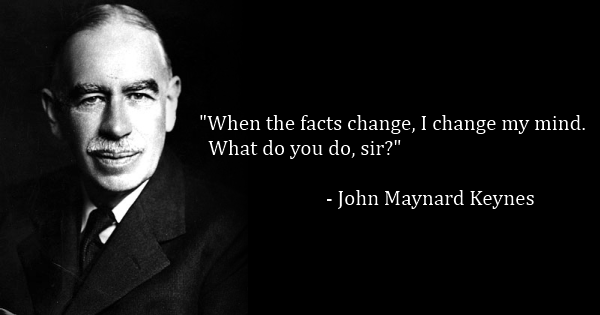
The post below updates the UAH record of air temperatures over land and ocean. But as an overview consider how recent rapid cooling has now completely overcome the warming from the last 3 El Ninos (1998, 2010 and 2016). The UAH record shows that the effects of the last one are now gone as of April 2021. (UAH baseline is now 1991-2020).
For reference I added an overlay of CO2 annual concentrations as measured at Mauna Loa. While temperatures fluctuated up and down ending flat, CO2 went up steadily by ~55 ppm, a 15% increase.
Furthermore, going back to previous warmings prior to the satellite record shows that the entire rise of 0.8C since 1947 is due to oceanic, not human activity.
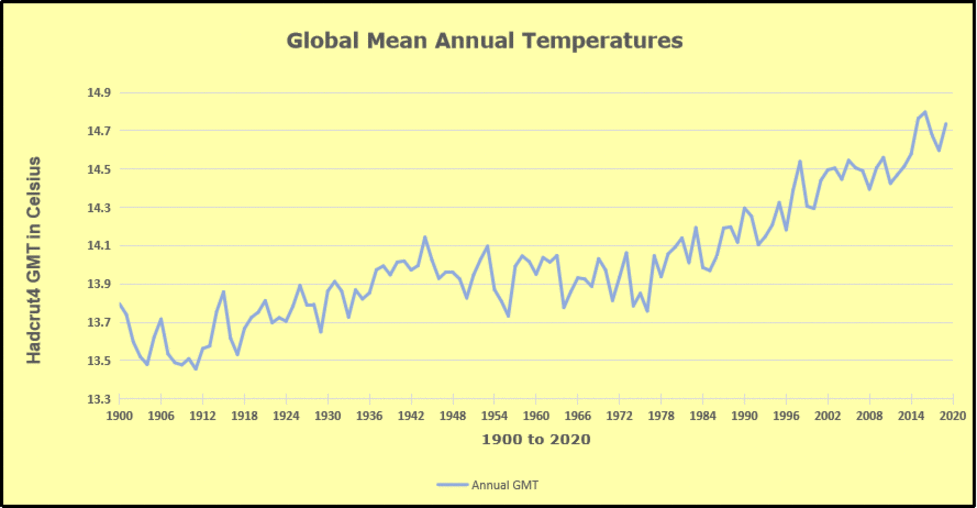
The animation is an update of a previous analysis from Dr. Murry Salby. These graphs use Hadcrut4 and include the 2016 El Nino warming event. The exhibit shows since 1947 GMT warmed by 0.8 C, from 13.9 to 14.7, as estimated by Hadcrut4. This resulted from three natural warming events involving ocean cycles. The most recent rise 2013-16 lifted temperatures by 0.2C. Previously the 1997-98 El Nino produced a plateau increase of 0.4C. Before that, a rise from 1977-81 added 0.2C to start the warming since 1947.
Importantly, the theory of human-caused global warming asserts that increasing CO2 in the atmosphere changes the baseline and causes systemic warming in our climate. On the contrary, all of the warming since 1947 was episodic, coming from three brief events associated with oceanic cycles.
Update August 3, 2021
Chris Schoeneveld has produced a similar graph to the animation above, with a temperature series combining HadCRUT4 and UAH6. H/T WUWT

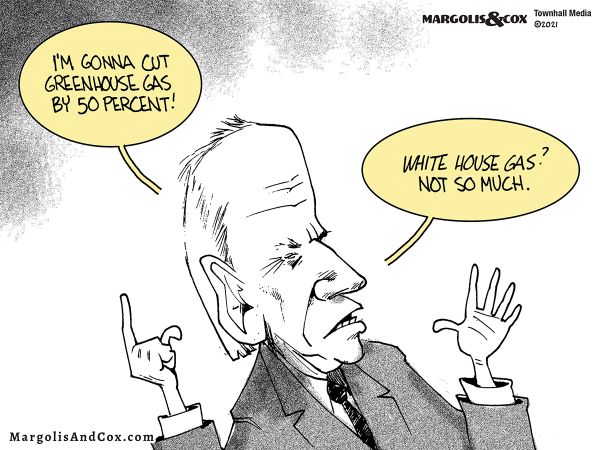
See Also Worst Threat: Greenhouse Gas or Quiet Sun?
April Update Ocean and Land Air Temps Continue Down

With apologies to Paul Revere, this post is on the lookout for cooler weather with an eye on both the Land and the Sea. While you will hear a lot about 2020 temperatures matching 2016 as the highest ever, that spin ignores how fast is the cooling setting in. The UAH data analyzed below shows that warming from the last El Nino is now fully dissipated with chilly temperatures setting in all regions. Last month it was the ocean cooling off dramatically.
UAH has updated their tlt (temperatures in lower troposphere) dataset for April. Previously I have done posts on their reading of ocean air temps as a prelude to updated records from HADSST3. This month also has a separate graph of land air temps because the comparisons and contrasts are interesting as we contemplate possible cooling in coming months and years. Unusually, last month showed air over land remained cool, while oceans dropped down further.
Note: UAH has shifted their baseline from 1981-2010 to 1991-2020 beginning with January 2021. In the charts below, the trends and fluctuations remain the same but the anomaly values change with the baseline reference shift.

Presently sea surface temperatures (SST) are the best available indicator of heat content gained or lost from earth’s climate system. Enthalpy is the thermodynamic term for total heat content in a system, and humidity differences in air parcels affect enthalpy. Measuring water temperature directly avoids distorted impressions from air measurements. In addition, ocean covers 71% of the planet surface and thus dominates surface temperature estimates. Eventually we will likely have reliable means of recording water temperatures at depth.
Recently, Dr. Ole Humlum reported from his research that air temperatures lag 2-3 months behind changes in SST. Thus the cooling oceans now portend cooling land air temperatures to follow. He also observed that changes in CO2 atmospheric concentrations lag behind SST by 11-12 months. This latter point is addressed in a previous post Who to Blame for Rising CO2?
After a technical enhancement to HadSST3 delayed updates Spring 2020, May resumed a pattern of HadSST updates toward the following month end. For comparison we can look at lower troposphere temperatures (TLT) from UAHv6 which are now posted for April. The temperature record is derived from microwave sounding units (MSU) on board satellites like the one pictured above. Recently there was a change in UAH processing of satellite drift corrections, including dropping one platform which can no longer be corrected. The graphs below are taken from the new and current dataset.
The UAH dataset includes temperature results for air above the oceans, and thus should be most comparable to the SSTs. There is the additional feature that ocean air temps avoid Urban Heat Islands (UHI). The graph below shows monthly anomalies for ocean temps since January 2015.
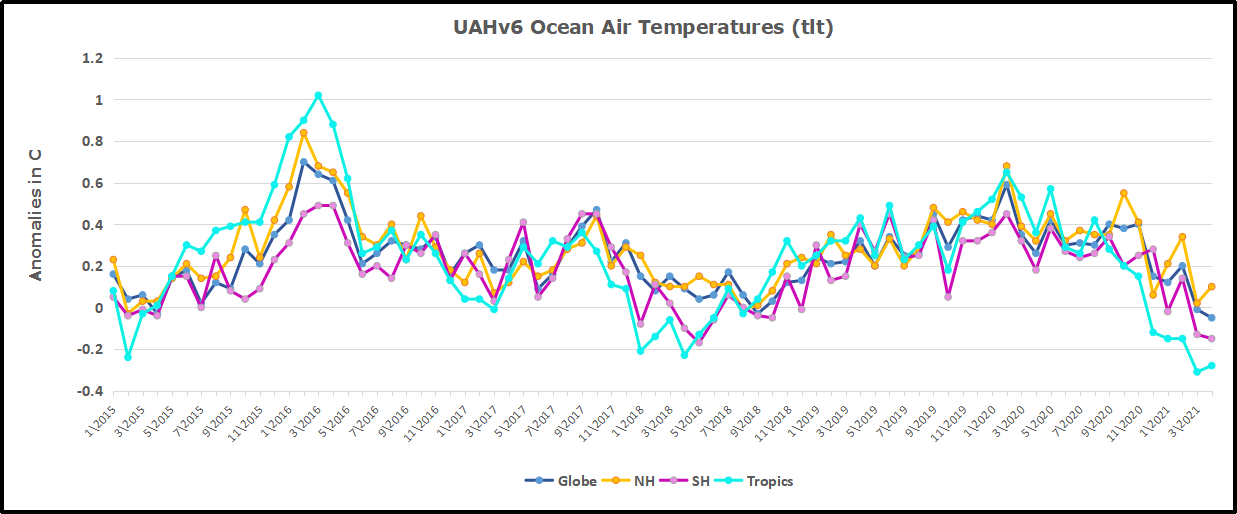 Note 2020 was warmed mainly by a spike in February in all regions, and secondarily by an October spike in NH alone. End of 2020 November and December ocean temps plummeted in NH and the Tropics. In January SH dropped sharply, pulling the Global anomaly down despite an upward bump in NH. An additional drop in March has SH matching the coldest in this period. March drops in the Tropics and NH make those regions at their coldest since 01/2015. In April despite an uptick in NH, the Global anomaly dropped further.
Note 2020 was warmed mainly by a spike in February in all regions, and secondarily by an October spike in NH alone. End of 2020 November and December ocean temps plummeted in NH and the Tropics. In January SH dropped sharply, pulling the Global anomaly down despite an upward bump in NH. An additional drop in March has SH matching the coldest in this period. March drops in the Tropics and NH make those regions at their coldest since 01/2015. In April despite an uptick in NH, the Global anomaly dropped further.
Land Air Temperatures Tracking Downward in Seesaw Pattern
We sometimes overlook that in climate temperature records, while the oceans are measured directly with SSTs, land temps are measured only indirectly. The land temperature records at surface stations sample air temps at 2 meters above ground. UAH gives tlt anomalies for air over land separately from ocean air temps. The graph updated for April is below.
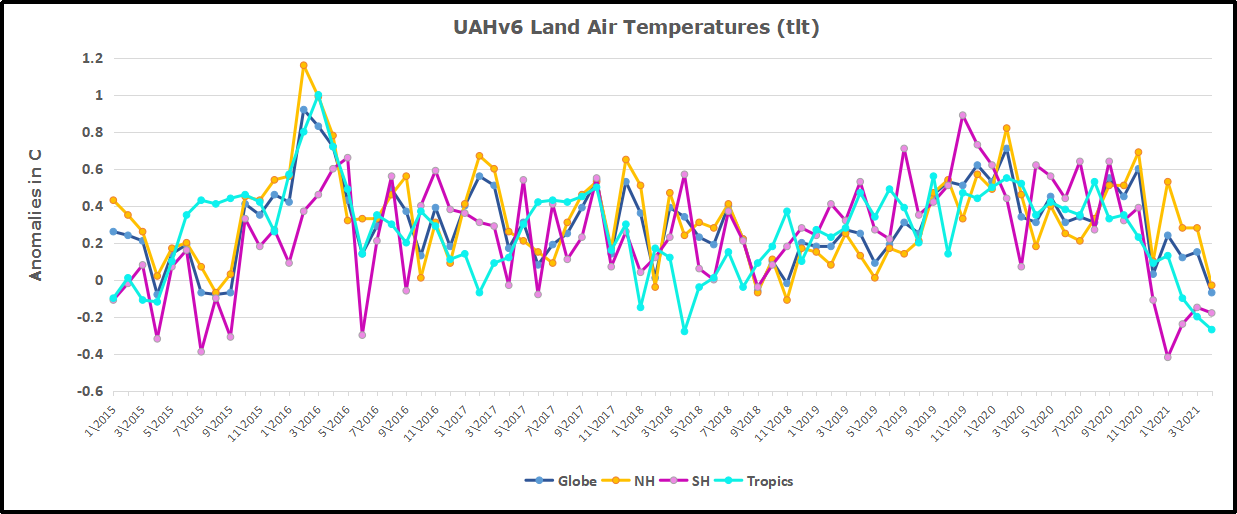
Here we have fresh evidence of the greater volatility of the Land temperatures, along with an extraordinary departure by SH land. Land temps are dominated by NH with a 2020 spike in February, followed by cooling down to July. Then NH land warmed with a second spike in November. Note the mid-year spikes in SH winter months. In December all of that was wiped out. Then January showed a sharp drop in SH, but a rise in NH more than offset, pulling the Global anomaly upward. In February NH and the Tropics cooled further, pulling down the Global anomaly, despite slight SH land warming. March continued to show all regions roughly comparable to early 2015, prior to the 2016 El Nino. Then in April NH land dropped sharply along with the Tropics, bringing Global Land anomaly down by nearly 0.2C. With NH having most of the land mass, it’s possible the additional Polar Vortex events drove air temps downward last month.
The Bigger Picture UAH Global Since 1995
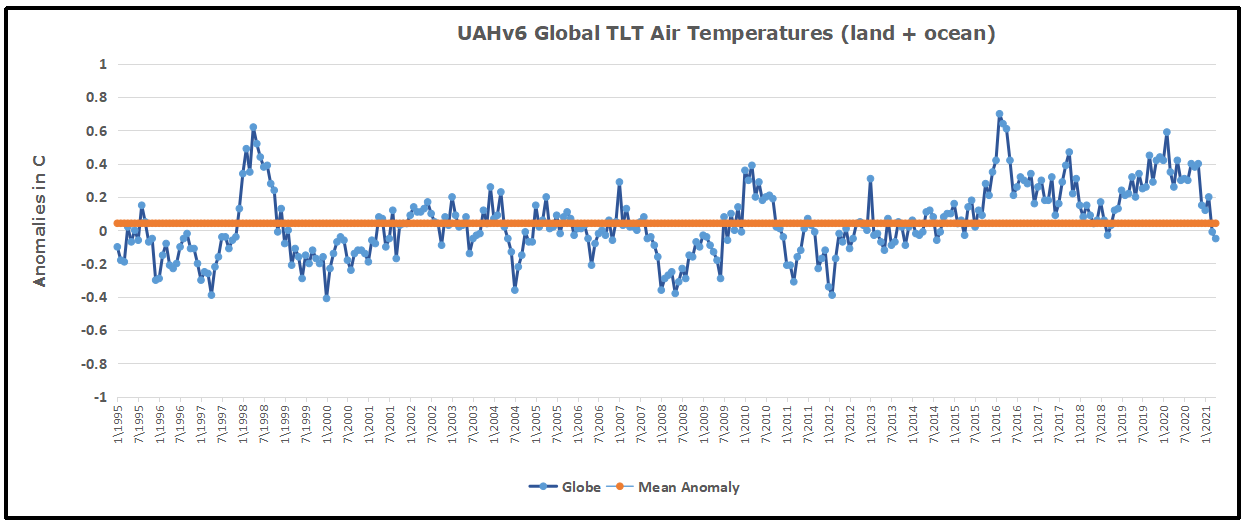
The chart shows monthly anomalies starting 01/1995 to present. The average anomaly is 0.04, since this period is the same as the new baseline, lacking only the first 4 years. 1995 was chosen as an ENSO neutral year. The graph shows the 1998 El Nino after which the mean resumed, and again after the smaller 2010 event. The 2016 El Nino matched 1998 peak and in addition NH after effects lasted longer, followed by the NH warming 2019-20, with temps now returning again to the mean.
TLTs include mixing above the oceans and probably some influence from nearby more volatile land temps. Clearly NH and Global land temps have been dropping in a seesaw pattern, more than 1C lower than the 2016 peak. Since the ocean has 1000 times the heat capacity as the atmosphere, that cooling is a significant driving force. TLT measures started the recent cooling later than SSTs from HadSST3, but are now showing the same pattern. It seems obvious that despite the three El Ninos, their warming has not persisted, and without them it would probably have cooled since 1995. Of course, the future has not yet been written.
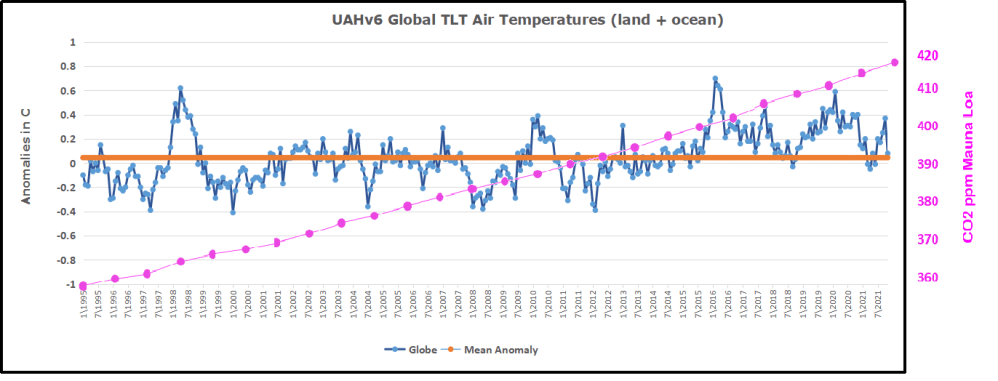
Reblogged this on Climate Collections.
LikeLike
I note that a like came from Jonathan DuHamel, whose writing on science and the climate issue I appreciated starting many years ago. Recently he published a compilation at his blog, which I summarized here:
WryHeat Climate Wisdom
LikeLiked by 1 person
Reblogged this on Tallbloke's Talkshop and commented:
We await to see what effect, if any, the current low-sunspot solar cycles may have on the intensity and frequency of the next few El Niños.
LikeLiked by 1 person
Reblogged this on WeatherAction News and commented:
It will be interesting if a Niña develops again and how this would affect temperatures. However a large enough VEI eruption that pumps into the stratosphere would be a real source throw. Either way it’s not looking likely run away warming is anything to worry about in the next decade 🤔
LikeLike
What is UAH? I find it unacceptable that writers, attempting to sway our thoughts, use acronyms with which we are not familiar.
LikeLike
Thomas, the reference is to the temperature dataset produced by University of Alabama Huntsville using satellite sensors. The website is here: https://www.nsstc.uah.edu/climate/
HadCRUT4 is a dataset built on surface station records and sea surface temperature data. Their website is here: https://www.metoffice.gov.uk/hadobs/hadcrut4/
LikeLike
I believe that the introductory quote, which is often attributed to Keynes, was actually due to Samuelson.
LikeLike
Yes, it’s confusing since Samuelson said it in 1970, yet in 1978 he credited Keynes for the quote.
Amusingly, Samuelson is also quoted as saying “If Parliament asked six economists for an opinion on any subject, they always got seven answers. Two from John Maynard Keynes.”
Some one else said the purpose of climate scientists is to make economists look good.
LikeLike
The sheer mass of data, including elements we’re not even aware of as yet, is far more than anything we’ve imagined, and those who believe the science is settled are either extremely ignorant, thoughtless, or deceitful. Maybe a couple honestly believe, but they fall into the first two categories.
LikeLike
Reblogged this on muunyayo and commented:
VIRUS-CYBER-CLIMATE EMERGENCY HOAXES
LikeLike
May I suggest that you correct Mauna Loa on the first graph. I love the data but misspellings make it look bush league.
LikeLike
Thanks. Fixed.
LikeLike